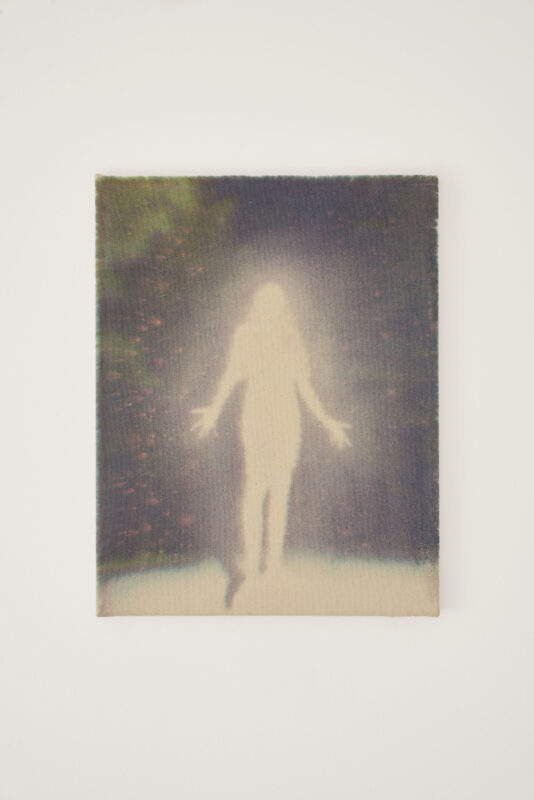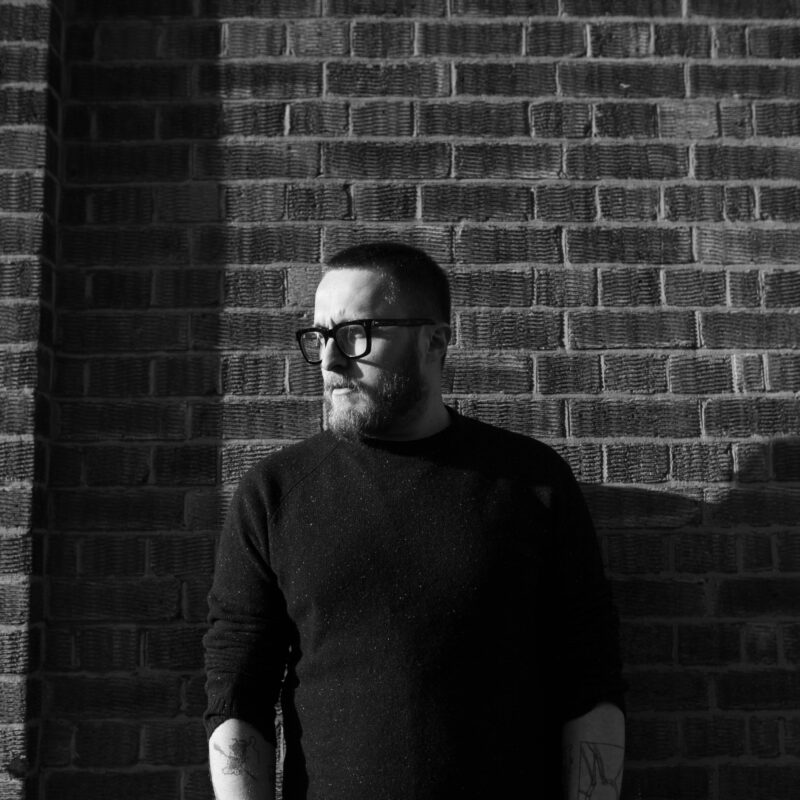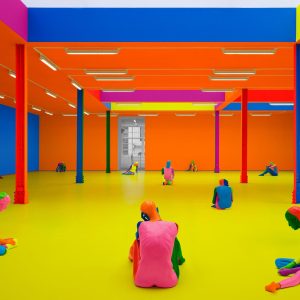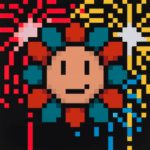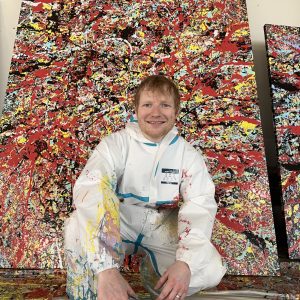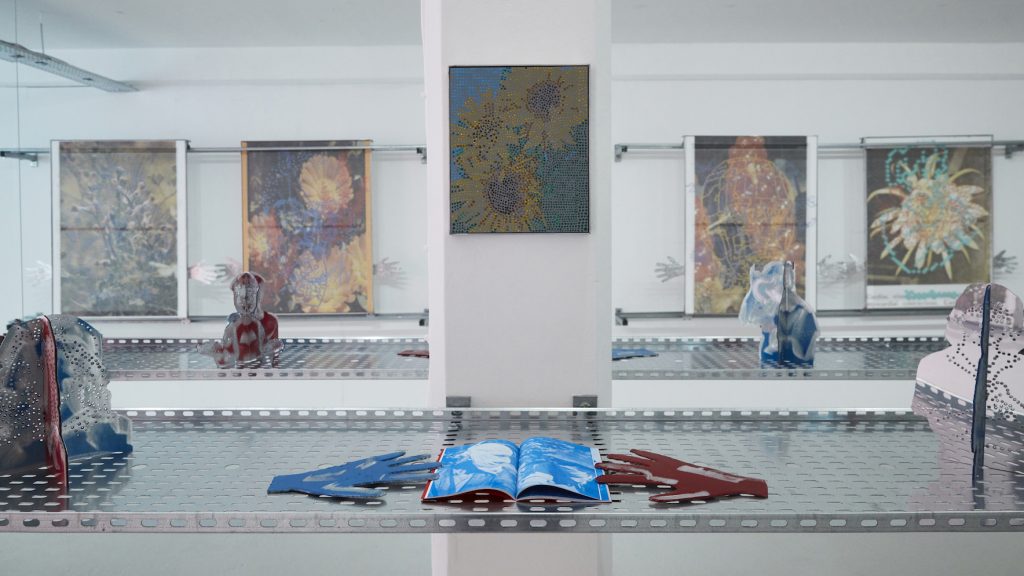
Elliot Fox, Idol Hands, Platform Southwark. Photography: Alex Sains
London based artist Elliot Fox recently sat down with art historian, writer and curator Hector Campbell to discuss his interest in alternative means of communication, his latest publication, his inclusion in Collective Ending HQ’s upcoming member’s exhibition and his current solo exhibition Idol Hands, also curated by Campbell, which runs at Platform Southwark in Central London until October 10th.
Hector Campbell: Idol Hands is your third solo exhibition since graduating from Camberwell College of Arts in 2014 with a BA (Hons) in Fine Art Painting, following 2017’s Scratching a Different Itch at Golborne Gallery and 2019’s Safe Hands at Sassoon Gallery with Altera Collective. How have you found the adjustment from arts education to practising artist?
Elliot Fox: For me personally, it’s been a very gradual process, I spent the immediate years post-graduation a little disillusioned with the idea of making work or pursuing shows. When the opportunity arose for Scratching A Different Itch in 2017 it seemed to re-ignite something in me, and I was a lot better equipped to translate my ideas and experiences. That felt like the start of me taking it a lot more seriously and since then I’ve wholeheartedly thrown myself Into being a practising artist.
H.C: Those familiar with your work will recognise your repeated use of alternative language forms such as braille and sign language again evident in the work on display in Idol Hands, as well as the addition of morse code in the form of an accompanying sound piece. What first drew you to these substitute methods of communication? And what do you hope to achieve through the use of their iconography?
E.F: Language has always played a very prevalent role in my work. If you look back to my older work you will see the use of repeated motifs to create my own language structure – I wanted to play with the idea of allowing meaning or value to be implied to a certain image through its repetitive use and how that can begin to obtain an obscured or implied meaning. This idea led me to think about existing language structures and how they could possibly be utilised to convey the idea of meaning within a work. In allowing the audience to believe that there is some sort of definitive meaning entrenched within the work that acts as a direct invitation to engage with the works and also gives context to the use of repeated motifs and the conceptual foundations of the work.
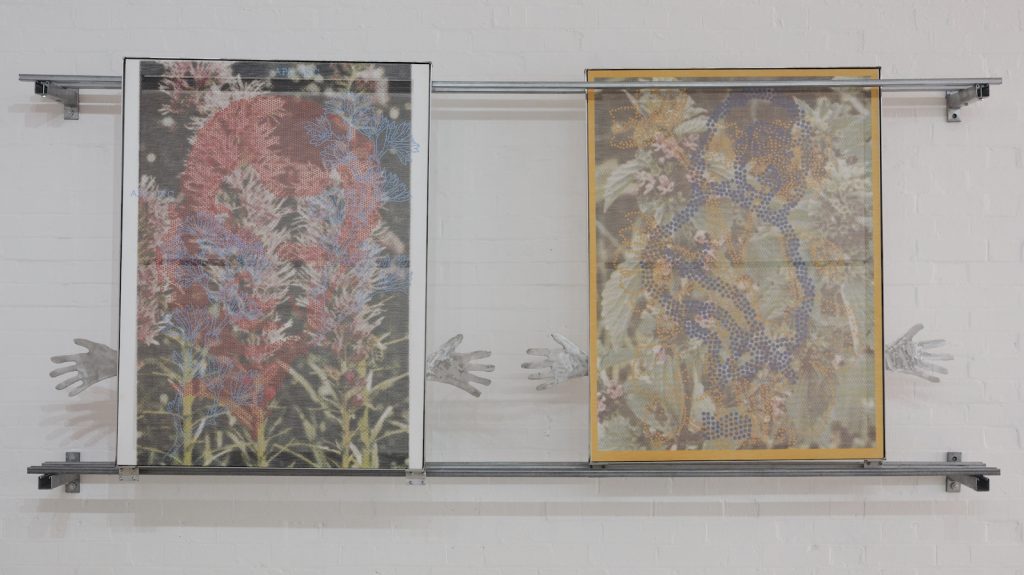
Elliot Fox, ‘The Sun Never Sets’ & ‘Gorse Bush’ (L-R), Digital painting on perforated PVC in aluminium housing on steel rail system, 123 x 93.5 cm (each), 2020. Photography: Alex Sains
H.C: Idol Hands further expands your experimentation with kinetic sculpture and audience engagement through the presentation of eight ‘digital paintings’ occupying four custom-designed railing systems. How did you become interested in the possibility of participatory viewers and the use of operational display methods?
E.F: The more I’ve exhibited my work, the more I’ve wanted to make the exhibition experience multifaceted and to dictate how people interact with the work. I spend a lot of time considering how people will engage with the works and how that engagement could be heightened through physical interaction. In this sense, I believe that the physical interaction that occurs between the audience and the work leads to a more active and intimate relationship.
The themes of post-industrialism and it’s subcultures that are concurrent in the show consider the relationship between humans and machines. The rail system and the audience engagement was in my mind as a way of referencing this relationship – much in the way we did during and after industrialisation through manufacturing or the aforementioned sub-cultured that followed.
H.C: This latest body of work exhibited in Idol Hands sees the introduction of natural imagery through the portrayal of flowers in your paintings, as well as the sculptural use of reclaimed Cornish Gorse. When did you first begin to include these floral depictions in your work, and why?
E.F: For a long time my work has referenced the place in which it was made – both in its materials and its imagery – and has mainly been concerned with industrial references. On my daily journeys around South London I kept seeing this motif of neon hand holding a rose repeated in windows of the city’s nail salons, so I started to use this logo in my work. I think out of context it began to reference all these other ideas that I was also interested in, and this combination of the natural and the manmade became more relevant to me. The duality of the places that have had an impact on me in my own personal life was beginning to find a synergy in my work and I wanted this show to harness that. The idea was to create a body of work that has real tension and yet a harmony about it – a combination of elements which are both ancient and futuristic.
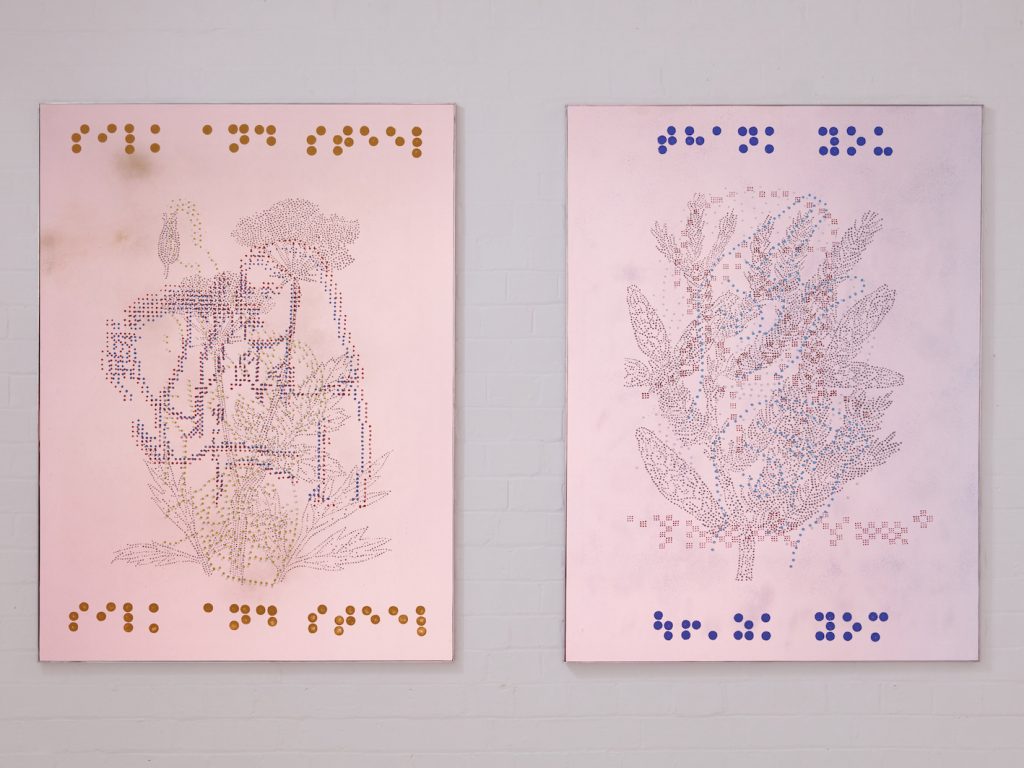
Elliot Fox, ‘Meaning’ & ‘Hard To See’ (L-R), Acrylic and spray paint on reflective material in artists frame, 122.5 x 92 cm (each), 2020. Photography: Alex Sains
H.C: Many of the artworks on display in Idol Hands incorporate reflective or mirrored material, and the exhibition installation itself utilises custom lighting effects and light filters, creating an ever-changing gallery environment and viewing experience. How do you hope that these extrinsic elements add to the audience’s appreciation of the artworks themselves?
E.F: Just as I was eager to create a body of work that contained tension and harmony, so too I wanted to embed that feeling within the exhibition space. I wanted people to engage with the work whilst not being able to find a fixed point with which to work off. The fact that this exhibition is ever-changing and moving again references the idea of the organic and in my view the post-humanist – of the natural and the technological mimicking one another until the lines are completely blurred. The work becomes dependent on the natural light within the space – as the sun fades or moves across the window from blue to red panel – it changes the work and creates a harmony between the viewer, the natural world and the artwork’s materials.
Another important consideration for me was giving the work access points through its use of reflections and lights that have an instant relationship with the audience. The main thinking behind the physical exhibition was that each visitor would experience the show completely differently, and so I would hope that would allow for a more personal response to the work.
H.C: Additionally, the installation of Idol Hands also involves the aforementioned supporting soundscape, produced in collaboration with Kieran Whitefield & Ellis Deaves, that marries morse code with rave or dance music. What was your intention with the addition of this aural accompaniment?
E.F: The soundscape actually contains a script that is repeated throughout the exhibition, in the titles of the artworks and the different braille and sign language forms within the paintings. The sound piece takes all these snippets of language and converts them into morse code to create a script that acts as a tangible thread throughout the exhibition. This script is also published in Braille in the accompanying Idol Hands publication.
Additionally, the soundscape acts to reference the themes of post-industrial subcultures evident within the exhibition. The repetitive nature of the morse code merges naturally with elements of dance or rave music, allowing the audience to transcend the physical exhibition space and be transported to those dance spaces, thus informing the way in which they communicate with the works. The inherent repetitiveness of electronic music itself also mirrors the productive hum of the machines that often shared the same spaces as those sub-cultures. It’s the noise that says to you ‘Keep Working!’ as much as it does ‘Keep Dancing!’. Once industrialism dissolved that void was filled by these subcultural movements, and the exhibition’s title Idol Hands directly references the space between those two worlds. For me personally, I think I’ve experienced a similar journey but in reverse. The transcendent headspace you find in making is so similar to that of a hedonistic one.

Elliot Fox, ‘Red/Blue’, Aluminium composite panel maquettes x 6, cornish gorse with spray paint x 4, plasma cut aluminium hands with spray paint x 4, ‘Idol Hands’ publication (published by Foolscap Editions) x 2, 2020. Photography: Alex Sains
H.C: Idol Hands coincides with the release of your latest publication, of the same name, designed by George Hatton and published by Foolscap Editions (who also released your debut book Body Work in 2017). The Idol Hands publication features much of your reference image and initial drawings/designs for the latest body of work, as well as a supplementary essay by Charlie Mills. How was the process of working on your second publication? Is the book intended as a compliment to the exhibition, or can it be appreciated as a stand-alone project?
E.F: I see the Idol Hands publication as a reference point for the exhibition that allows the audience to understand the research elements of the show. I’m so lucky that Daniel (Fletcher, founder of Foolscap Edition), George and Charlie all fully understood what I was trying to achieve and added their own influence along the way. From a technical and a conceptual sense they helped me to create what I think of as a reflection of the exhibition, and one that will live on long after the show has finished – it is as much a part of the exhibition as anything else.
The images in the book are taken from archives of Cornish mining and warehouse raves, both from the late ’80s or early ’90s. The publication also further expands upon the language forms found within the artworks such as the braille translations or sign language interpretations, but also other elements of the exhibition such as my original floral drawings and insights into the original technical plans for the installation.
I hope the book helps to acknowledge the relationship of language to print and those aspects that are present in the show – be that in the technical approach to painting that mimics this mass production of printing or the repetition of hand-rendered dots throughout. The exhibition is almost an explosion of the ideas that were generated in the book – from the imagery used to the way one turns a page in a publication – thinking about images moving across and over each other, hiding, building and adding meaning as you move along
H.C: Finally, you’re currently a member of Collective Ending HQ, a studio and gallery complex in Deptford, South East London and are working towards the first annual member’s exhibition, to be expected mid-late October. Could you give us any insight into the work you’re creating for that upcoming exhibition? Will you continue to explore some of the themes prevalent in Idol Hands?
E.F: I will be yes, actually the Cornish gorse used within the exhibition was picked from a monument near where I grew up, and for the upcoming CE HQ members exhibition, I’ll be re-interpreting this monument as a new sculpture.
The monument was built in the honour and memory of a local businessman and sees a ritualistic festival held there once a year that involves curious performative elements. I am, however, more interested in the local legend that surrounds the monument. Knill, the man in question, was known to have amassed his fortune through smuggling, and the giant pyramid-like structure was actually a communicative symbol previously used to allow boats to view the skyline to land safely. I’m really interested in the idea of how objects are used to communicate, and especially this idea of immortalising yourself in this message.
Elliot Fox, Idol Hands at Platform Southwark, curated by Hector Campbell, runs until October 10th.
platformsouthwark.co.uk
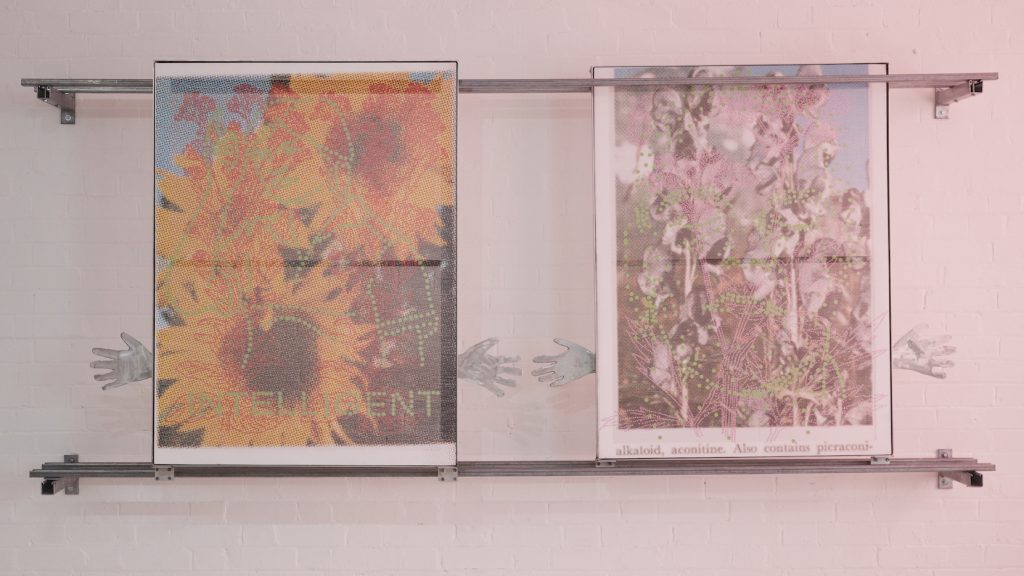
Elliot Fox, ‘Thank You’ & ‘House’ (L-R), Digital painting on perforated PVC in aluminium housing on steel rail system, 123 x 93.5 cm (each), 2020. Photography: Alex Sains

